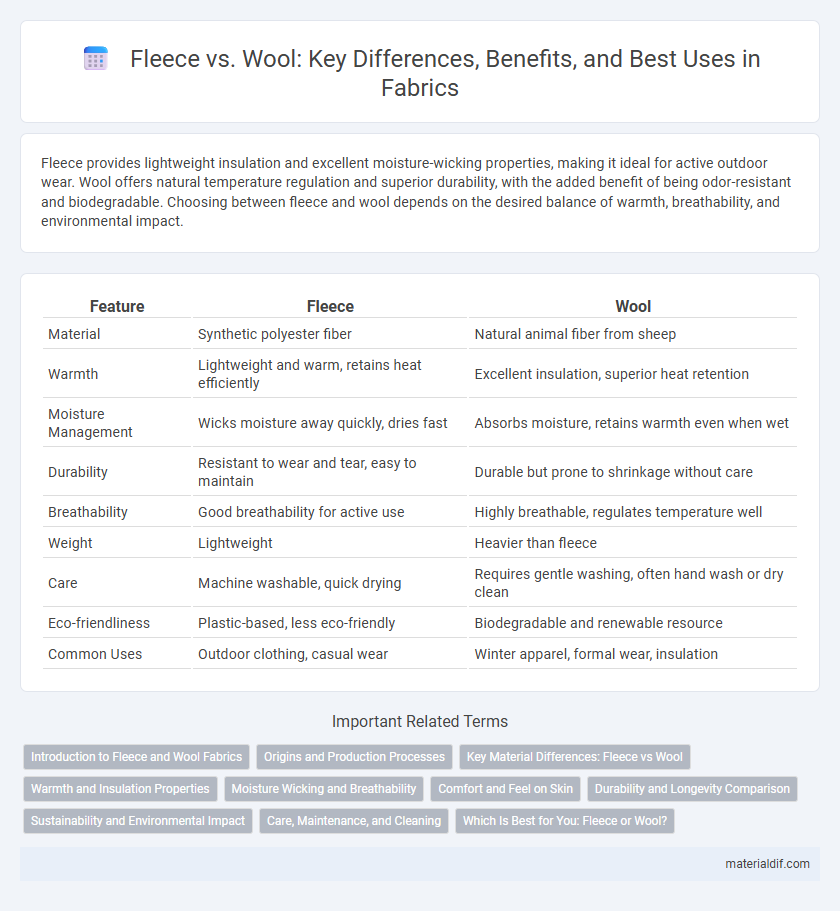Fleece provides lightweight insulation and excellent moisture-wicking properties, making it ideal for active outdoor wear. Wool offers natural temperature regulation and superior durability, with the added benefit of being odor-resistant and biodegradable. Choosing between fleece and wool depends on the desired balance of warmth, breathability, and environmental impact.
Table of Comparison
| Feature | Fleece | Wool |
|---|---|---|
| Material | Synthetic polyester fiber | Natural animal fiber from sheep |
| Warmth | Lightweight and warm, retains heat efficiently | Excellent insulation, superior heat retention |
| Moisture Management | Wicks moisture away quickly, dries fast | Absorbs moisture, retains warmth even when wet |
| Durability | Resistant to wear and tear, easy to maintain | Durable but prone to shrinkage without care |
| Breathability | Good breathability for active use | Highly breathable, regulates temperature well |
| Weight | Lightweight | Heavier than fleece |
| Care | Machine washable, quick drying | Requires gentle washing, often hand wash or dry clean |
| Eco-friendliness | Plastic-based, less eco-friendly | Biodegradable and renewable resource |
| Common Uses | Outdoor clothing, casual wear | Winter apparel, formal wear, insulation |
Introduction to Fleece and Wool Fabrics
Fleece fabric, typically made from synthetic fibers like polyester, offers lightweight insulation and moisture-wicking properties ideal for activewear and casual outerwear. Wool, sourced from sheep, provides natural warmth, breathability, and durability, making it a traditional choice for cold-weather garments and high-quality textiles. Both fabrics serve distinct functions, with fleece excelling in quick-drying and wool standing out for its temperature regulation and eco-friendly attributes.
Origins and Production Processes
Fleece is typically made from synthetic fibers like polyester, produced through polymer extrusion and knitting or weaving processes designed for lightweight, insulating fabrics. Wool originates from the natural fleece of sheep, primarily produced via shearing, followed by cleaning, carding, and spinning fibers into yarn. The distinct production methods influence fleece's synthetic durability and wool's natural breathability and moisture-wicking properties.
Key Material Differences: Fleece vs Wool
Fleece is a synthetic fabric typically made from polyester fibers, known for its lightweight, quick-drying, and moisture-wicking properties, making it ideal for activewear and outdoor use. Wool, derived from sheep, offers superior insulation, breathability, and natural odor resistance due to its moisture-absorbing lanolin content, providing warmth even when wet. Unlike wool, fleece is easy to care for and dries faster, but it lacks the natural temperature regulation and durability inherent in wool fibers.
Warmth and Insulation Properties
Fleece provides excellent warmth due to its synthetic fibers that trap heat efficiently, making it lightweight and moisture-resistant. Wool offers superior insulation by naturally regulating body temperature through its breathable, moisture-wicking fibers, ensuring warmth even when damp. Both materials excel in thermal retention, but wool's natural fibers often outperform fleece in maintaining consistent warmth in varied conditions.
Moisture Wicking and Breathability
Fleece excels in moisture-wicking by rapidly drawing sweat away from the skin, keeping the wearer dry during high-activity conditions. Wool offers superior breathability due to its natural fiber structure, which allows air circulation while retaining warmth even when damp. Both fabrics provide effective moisture management, but fleece is preferred for intense workouts, whereas wool is ideal for versatile outdoor use.
Comfort and Feel on Skin
Fleece offers exceptional softness and lightweight warmth, making it ideal for sensitive skin and active wear due to its moisture-wicking properties. Wool provides natural insulation and breathability but can sometimes feel coarse or itchy, especially for those with delicate skin. Both fabrics excel in comfort, with fleece favored for its smooth texture and wool valued for its temperature regulation.
Durability and Longevity Comparison
Fleece is a synthetic fabric known for its lightweight durability, resisting pilling and maintaining shape after repeated washes, making it ideal for activewear. Wool, a natural fiber, offers exceptional longevity due to its resilient protein structure that withstands wear and tear while providing natural moisture-wicking and insulation properties. Both fabrics excel in durability, but wool typically outlasts fleece in long-term use due to its ability to self-repair minor damage and resist odors.
Sustainability and Environmental Impact
Fleece, typically made from synthetic polyester derived from petroleum, has a lower biodegradability and contributes to microplastic pollution in waterways, raising concerns about long-term environmental impact. Wool, a natural and renewable fiber obtained from sheep, is biodegradable, promotes soil health through grazing management, and has a smaller carbon footprint when sourced responsibly. Choosing sustainably produced wool reduces dependence on fossil fuels and supports ecosystems, whereas fleece production relies heavily on non-renewable resources and energy-intensive manufacturing processes.
Care, Maintenance, and Cleaning
Fleece fabric requires simple care with machine washing in cold water and low heat drying, resisting shrinking and pilling. Wool demands more delicate maintenance, often requiring hand washing or dry cleaning to avoid felting and shrinking, along with specialized wool detergents. Proper care preserves fleece's durability and wool's insulating properties, ensuring longevity for both fabrics.
Which Is Best for You: Fleece or Wool?
Fleece offers lightweight warmth, moisture-wicking properties, and quick drying, making it ideal for active outdoor wear. Wool provides superior insulation, natural odor resistance, and excellent temperature regulation, perfect for cold, damp environments. Your choice depends on activity level, climate, and personal comfort preferences.
Fleece vs Wool Infographic

 materialdif.com
materialdif.com